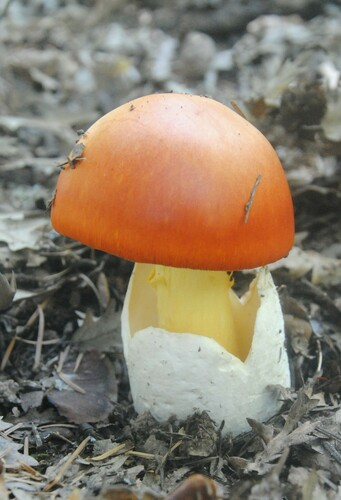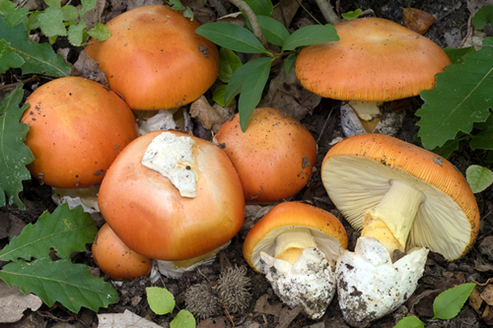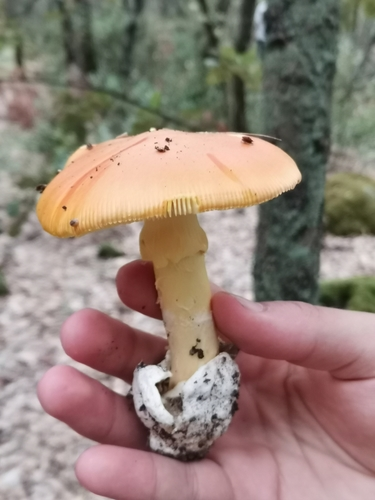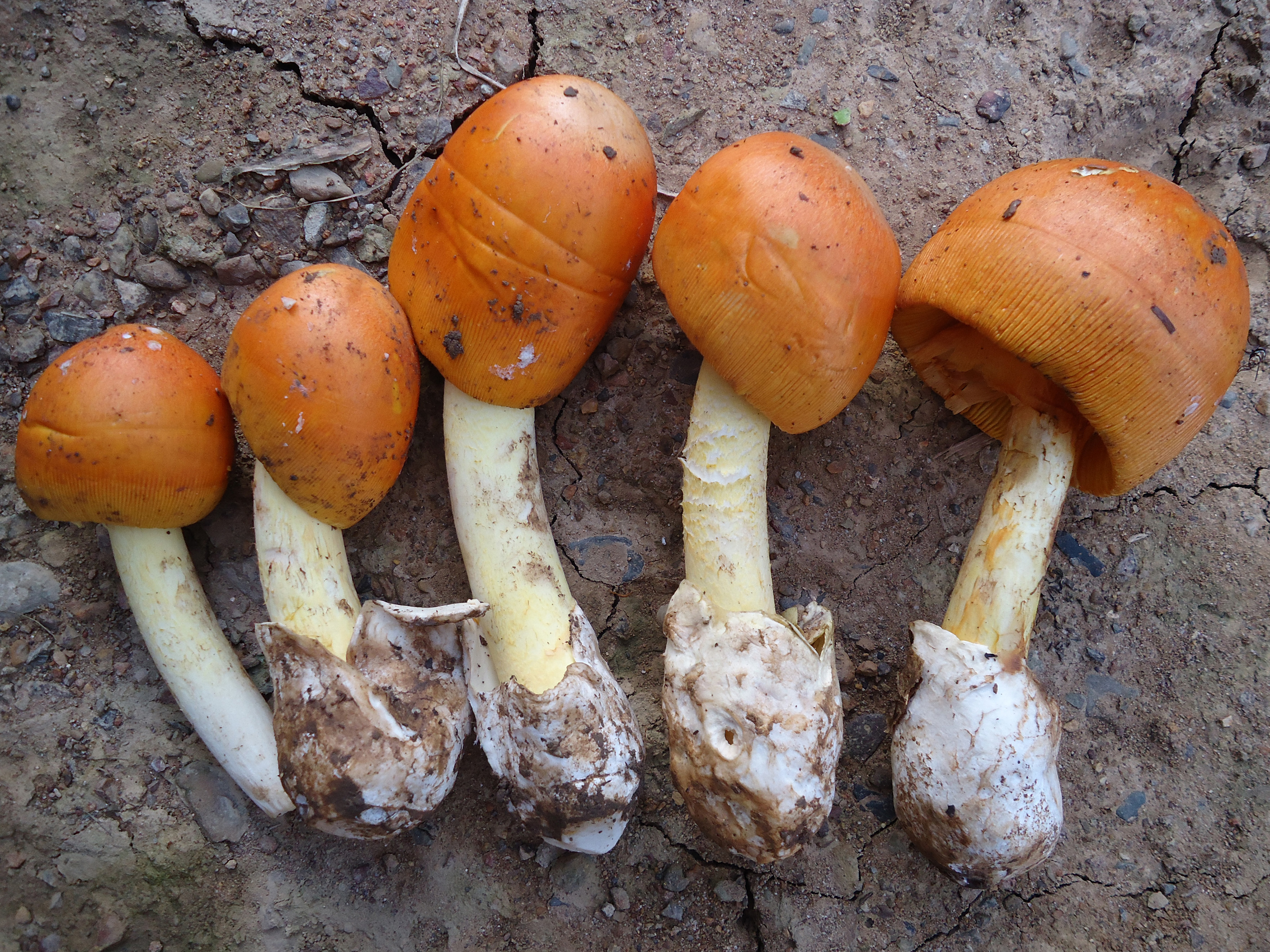ເລກລຳດັບທີ: 131
ລະດັບການຮວບຮວມຂໍ້ມູນ: ເກີອບສົມບູນ
ປັບປູງຄັ້ງລ່າສຸດ: 2024-10-19
ເຫັດລະໂງກແດງ
Caesar's mushroom
Amanita caesarea (Scop.) Pers.
ເຊື້ອເຫັດ
ເຊື້ອຣາທີ່ເກີດຕາມດິນ
×
ຊື່ທ້ອງຖີ່ນ:
( Caesar'S Amanita, Caesar'S Mushroom)
ຊື່ພ້ອງ
:
Agaricus aurantiacus Bull.
Agaricus aurantius Bull., 1783
Agaricus aureus Batsch
Agaricus caesareus Schaeff.
Agaricus caesareus Scop.
Amanita aurantia Lam.
Amanita aurantiaca (Bull.) Lam.
Amanita aurantiaca Pers.
Amanita bulbosa var. alba Gillet, 1874
Amanita caesarea f. alba E.-J.Gilbert, 1918
Amanita caesarea f. lutea (Gillet) Neville & Poumarat
Amanita caesarea var. alba Gillet
Amanita caesarea var. aurantia Gillet
Amanita caesarea var. lutea Gillet
Amanita caesarea var. rubra Gillet
Fungus caesareus Kuntze
Helvella ciceronis Battarra
Hypophyllum caesareum (Scop.) Paulet
Venenarius caesareus (Scop.) Murrill
Volvoamanita caesarea (Scop.) Beck, 1922
Volvoamanita caesarea (Scop.) E.Horak
Agaricus aurantius Bull., 1783
Agaricus aureus Batsch
Agaricus caesareus Schaeff.
Agaricus caesareus Scop.
Amanita aurantia Lam.
Amanita aurantiaca (Bull.) Lam.
Amanita aurantiaca Pers.
Amanita bulbosa var. alba Gillet, 1874
Amanita caesarea f. alba E.-J.Gilbert, 1918
Amanita caesarea f. lutea (Gillet) Neville & Poumarat
Amanita caesarea var. alba Gillet
Amanita caesarea var. aurantia Gillet
Amanita caesarea var. lutea Gillet
Amanita caesarea var. rubra Gillet
Fungus caesareus Kuntze
Helvella ciceronis Battarra
Hypophyllum caesareum (Scop.) Paulet
Venenarius caesareus (Scop.) Murrill
Volvoamanita caesarea (Scop.) Beck, 1922
Volvoamanita caesarea (Scop.) E.Horak
ຊື່ສະກຸນ:
Amanitaceae
ຊະນິດໃກ້ຄຽງ:
ເຫັດລະໂງກເຫຼືອງ/ Yellow Half-dyed slender Caesar Mushroom
ເຫັດຂີ້ກະເດືອນ/ Grisette Mushroom
ເຫັດໄຂ່ຫ່ານ/ Head Man Slender Caesa
ເຫັດຂີ້ກະເດືອນ/ Grisette Mushroom
ເຫັດໄຂ່ຫ່ານ/ Head Man Slender Caesa
ບັນຍາຍລັກສະນະທາງພືດສາດ:
ເຫັດຊະນິດນີ້ສາມາດອອກດ໋ຍວ ຫຼື ອອກເປັນກຸ່ມຂະໜາດນ້ອຍໄດ້, ໂດຍປົກກະຕິຈະອອກເປັນກຸ່ມ 2 ຫາ 3 ດອກ.
ດອກເຫັດທີ່ຍັອ່ອນຈະມີສີຂາວ ແລະ ປ່ຽນເປັນສີແດງພາຍຫຼັງ, ໝວກເຫັດຈະຍາບ ແລະ ມີລັກສະນະຄ້າຍຖ້ວຍ, ໂດຍມີເສັ້ນຜ່າສູນກາງ 3 ຫາ 7 ຊມ.
ກ້ານເຫັດມີລັກສະນະຍາບ ແລະ ອາດເປັນສີຂາວ ຫຼື ສີເຫຼືອງ, ໂດຍມີຄວາມຍາວໄດ້ຮອດ 10 ຊມ. ແລະ ມີເສັນຜ່າສູນກາງ 0,5 ຫາ 1 ຊມ., ບໍລີມີວົງແຫນຢູ່ກ້ານສ່ວນເທິງ ແຕ່ ມີກາບຫຸ້ມຂະໜາດໃຫຍ່ທີ່ໂຄນກ້ານ.
ເຫງືອກ ຫຼື ຟັນຟືມ 7ໂຄງສ້າງໃຕ້ໝວກເຫັດ ເຮັດໜ້າທີ່ສ້າງສະປໍ), ສີເຫຼືອງ.
ແຫຼ່ງທີ່ມາ: [1]
ດອກເຫັດທີ່ຍັອ່ອນຈະມີສີຂາວ ແລະ ປ່ຽນເປັນສີແດງພາຍຫຼັງ, ໝວກເຫັດຈະຍາບ ແລະ ມີລັກສະນະຄ້າຍຖ້ວຍ, ໂດຍມີເສັ້ນຜ່າສູນກາງ 3 ຫາ 7 ຊມ.
ກ້ານເຫັດມີລັກສະນະຍາບ ແລະ ອາດເປັນສີຂາວ ຫຼື ສີເຫຼືອງ, ໂດຍມີຄວາມຍາວໄດ້ຮອດ 10 ຊມ. ແລະ ມີເສັນຜ່າສູນກາງ 0,5 ຫາ 1 ຊມ., ບໍລີມີວົງແຫນຢູ່ກ້ານສ່ວນເທິງ ແຕ່ ມີກາບຫຸ້ມຂະໜາດໃຫຍ່ທີ່ໂຄນກ້ານ.
ເຫງືອກ ຫຼື ຟັນຟືມ 7ໂຄງສ້າງໃຕ້ໝວກເຫັດ ເຮັດໜ້າທີ່ສ້າງສະປໍ), ສີເຫຼືອງ.
ແຫຼ່ງທີ່ມາ: [1]
ນິເວດວິທະຍາ
ເຂດກະຈາຍພັນທົ່ວໂລກ:
Native to Albania, Algeria, Austria, Belgium, Bulgaria, Croatia, Czechia, France, Georgia, Germany, Greece, Hungary, Italy, Montenegro, Morocco, North Macedonia, Portugal, Romania, Russian Federation, Serbia, Slovakia, Slovenia, Spain, Switzerland, Tunisia, Türkiye, Ukraine. [5]
ມີຖິ່ນກຳເນີດໃນ ແອວເບຍເນຍ, ແອວຈີເຣຍ, ອອສເຕເຣຍ, ເບວຍຽຽມ, ບັລແກເຣຍ, ໂຄເອເຊຍ, ເຊັກເກຍ, ຝຣັ່ງເສດ, ຈໍເຈຍ, ເຍີມານີ, ກີສ, ຮັງກາລີ, ອິຕາລີ້, ມອນເຕເນໂກ, ໂມຣັອກໂກ, ມາຊິໂດເນຍເໜືອ, ສະຫະພັນລັດເຊຍ, ເຊີເບຍ, ສະໂລວາເກຍ, ສະໂລວີເນຍ, ສະເປນ, ສະວິດເຊີແລນ, ຕູນີເຊຍ, ຕູລະກີ ແລະ ຢູເຄນ. [5]
Global distribution between 2004 to 2024. Source: [2]
ເຂດກະຈາຍພັນທົ່ວໂລກລະຫວ່າງປີ 2004 ຫາ 2024. ແຫຼ່ງຂໍ້ມູນ: [2]
ມີຖິ່ນກຳເນີດໃນ ແອວເບຍເນຍ, ແອວຈີເຣຍ, ອອສເຕເຣຍ, ເບວຍຽຽມ, ບັລແກເຣຍ, ໂຄເອເຊຍ, ເຊັກເກຍ, ຝຣັ່ງເສດ, ຈໍເຈຍ, ເຍີມານີ, ກີສ, ຮັງກາລີ, ອິຕາລີ້, ມອນເຕເນໂກ, ໂມຣັອກໂກ, ມາຊິໂດເນຍເໜືອ, ສະຫະພັນລັດເຊຍ, ເຊີເບຍ, ສະໂລວາເກຍ, ສະໂລວີເນຍ, ສະເປນ, ສະວິດເຊີແລນ, ຕູນີເຊຍ, ຕູລະກີ ແລະ ຢູເຄນ. [5]
Global distribution between 2004 to 2024. Source: [2]
ເຂດກະຈາຍພັນທົ່ວໂລກລະຫວ່າງປີ 2004 ຫາ 2024. ແຫຼ່ງຂໍ້ມູນ: [2]
ເຂດກະຈາຍພັນໃນລາວ
:
ເຂດພູສູງສາຍພູຫຼວງ ແລະ ເຂດພູພຽງແຂວງຊຽງຂວາງ

ເຂດກະຈາຍພັນຕາມພູມສັນຖານ
:
ປ່າປະສົມປ່ຽນໃບ
ປ່າແປກ
ປ່າແປກປະສົມປ່າໃບກ້ວາງ
ປ່າແປກ
ປ່າແປກປະສົມປ່າໃບກ້ວາງ
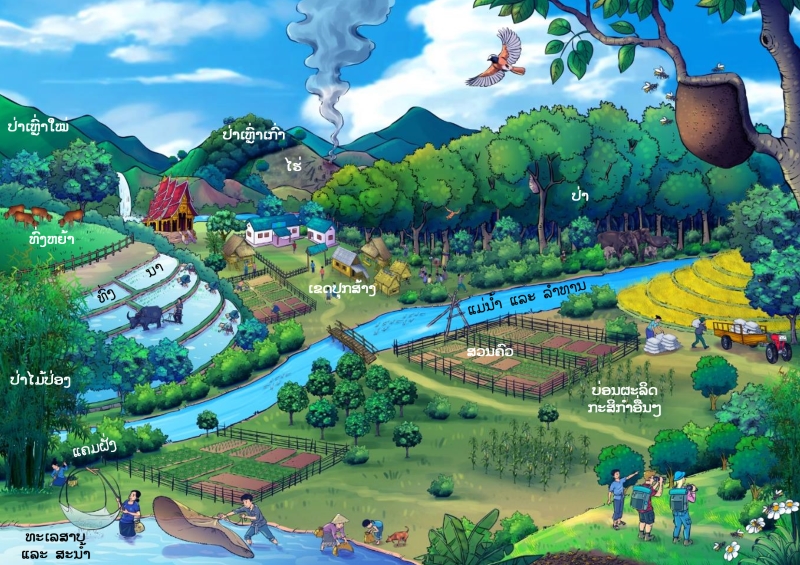
ສະເພາະຖິ່ນໃນລາວ:
ຕ່າງຖິ່ນ
ຮຸກຮານ
:
ບໍ່ຮຸກຮານ
ສະຖານະພາບການອະນູຮັກ IUCN
:
ມີຄວາມສ່ຽງໜ້ອຍສຸດ
ສະຖານະພາບການອະນຸຮັກແຫ່ງຊາດລາວ
:
ບັນຊີທີ່ III: ຊະນິດພັນປະເພດທົ່ວໄປ
ການນຳໃຊ້
ປະເພດການນຳໃຊ້:
ອາຫານ
ບັນຍາຍການນຳໃຊ້:
ອາຫານ: ໃນາວເຫັດຊະນິດນີ້ໃຊ້ປຸ່ງແຕ່ງອາຫານ, ແຕ່ເຫັດລະໂງກແດງບໍ່ໄດ້ຮັບຄວາມນິຍົມເທົ່າເຫັດລະໂງກຂາວ. [1]
ການປູກ ການລ້ຽງ:
ຊະນິດທຳມະຊາດ
ລະດູການເກັບກູ້:
ສິງຫາ
ກັນຍາ
ຕຸລາ
ພະຈິກ
ທັນວາ
ກັນຍາ
ຕຸລາ
ພະຈິກ
ທັນວາ
ການຕະຫຼາດ ແລະ ຕ່ອງໂສ້ມູນຄ່າ:
ຂາຍໃນລາຄາ 0,5 ຫາ 1 ດອນລາມ ເຫັດລະໂງກແດງມັກພົບໜ້ອຍກ່ວາເຫັດລະໂງກຂາວ. [1]
ການຄຸ້ມຄອງຈັດການ
ໄພຄຸກຄາມ: ໄພຄຸກຄາມທີ່ລະບຸໄດ້ຊັດເຈນທີ່ສຸດແມ່ນກ່ຽວກັບປ່າ ແລະ ການສະສົມໄນໂຕເຈັນໃນອາກາດ, ນອກຈາກນີ້ຍັງມີລາຍງານການເກັບກ່ຽວແບບດັບສູນ. [5]
ການຕິດຕາມປະຊາກອນ: ມີການລາຍງານວ່າເຫັດລະໂງກແດງ ໃນພື້ນທີ່ຕ່າງໆມີຫຼາຍກ່ວາ 500 ແຫ່ງໃນຢູໂຣບ (2015) ແລະ ຄາດວ່າວ່າຈະມີຈຳນວນທັງໝົດລວມທັງແຫຼ່ງທີ່ຢູ່ອາໄສ ທີ່ຍັງບໍ່ັທນໄດ້ບັນທຶກໄວ້ ອາດສູງກ່ວານີ້ 10 ເທົ່າ, ໂດຍສະຫຼຸບແລ້ວ ບໍ່ມີຫຼັກຖານໃດໆທີ່ບົ່ງຊີ້ວ່າ ຈຳນວນປະຊາກອນຫຼຸດລົງໃນະດັບໂລກ. [5]
ການຕິດຕາມປະຊາກອນ: ມີການລາຍງານວ່າເຫັດລະໂງກແດງ ໃນພື້ນທີ່ຕ່າງໆມີຫຼາຍກ່ວາ 500 ແຫ່ງໃນຢູໂຣບ (2015) ແລະ ຄາດວ່າວ່າຈະມີຈຳນວນທັງໝົດລວມທັງແຫຼ່ງທີ່ຢູ່ອາໄສ ທີ່ຍັງບໍ່ັທນໄດ້ບັນທຶກໄວ້ ອາດສູງກ່ວານີ້ 10 ເທົ່າ, ໂດຍສະຫຼຸບແລ້ວ ບໍ່ມີຫຼັກຖານໃດໆທີ່ບົ່ງຊີ້ວ່າ ຈຳນວນປະຊາກອນຫຼຸດລົງໃນະດັບໂລກ. [5]
ໂພຊະນາການ
ຄຸນຄ່າທາງໂພຊະນາການ:
ບັນຍາຍຄຸນຄ່າທາງໂພຊະນາການ:
N/A
| ສານອາຫານ | /100g | ໝາຍເຫດ |
|---|---|---|
| ໂປຣຕີນ | N/A | N/A |
| ຄາໂບໄຮເດຣດ | N/A | N/A |
| ໄຂມັນ | N/A | N/A |
| ວິຕາມິນ | N/A | N/A |
| ແຮ່ທາດ | N/A | N/A |
| ເສັ້ນໄຍ | N/A | N/A |
ອ້າງອິງ
ເຄດິດຮູບພາບ:
Caesar’s mushroom. [1] iNaturalist [Online]. Uploaded on 22 September 2023 by: salimeh. Available: www.inaturalist.org/photos/322463354. [Accessed: 01 October 2024].
Multiple Caesar's mushrooms. [2] iNaturalist [Online]. Uploaded in August 2021 by: federicocalledda. Available: https://www.inaturalist.org/photos/150285551. [Accessed: 01 October 2024].
Harvested Caesar's Mushroom. [3] iNaturalist [Online]. Uploaded on 20 October 2021 by: rolandgodon. Available: https://www.inaturalist.org/photos/164566798. [Accessed: 01 October 2024].
Multiple Caesar's mushrooms. [2] iNaturalist [Online]. Uploaded in August 2021 by: federicocalledda. Available: https://www.inaturalist.org/photos/150285551. [Accessed: 01 October 2024].
Harvested Caesar's Mushroom. [3] iNaturalist [Online]. Uploaded on 20 October 2021 by: rolandgodon. Available: https://www.inaturalist.org/photos/164566798. [Accessed: 01 October 2024].
ອ້າງອິງ:
[1] "100 Non-Timber Forest Products," Pha Khao Lao, Nov. 2024. [Online]. Available: https://phakhaolao.la/wp-content/uploads/2024/11/100_NTFPs.pdf. [Accessed: Apr. 3, 2025].
[2] Global Biodiversity Information Facility (GBIF), “Amanita caesarea (Scop.) Pers.” [Online]. Available: https://www.gbif.org/species/5240269. [Accessed: 01 October 2024].
[3] T. Læssøe and O. Sparre Pedersen, "Amanita species within section Caesareae from the highlands of Laos," Research Square, pp. 1-23, 2024.
[4] H. Huseyin Dogan and G. Akbas, "Biological activity and fatty acid composition of Caesar’s mushroom," Pharmaceutical Biology, vol. 10, no. 2, pp. 863-871, 2013.
[5] IUCN Red List, “Amanita caesarea (Fr.) A. David,” [Online]. Available: https://www.iucnredlist.org/species/125433663/125435485#bibliography. [Accessed: 10 July 2024].
[2] Global Biodiversity Information Facility (GBIF), “Amanita caesarea (Scop.) Pers.” [Online]. Available: https://www.gbif.org/species/5240269. [Accessed: 01 October 2024].
[3] T. Læssøe and O. Sparre Pedersen, "Amanita species within section Caesareae from the highlands of Laos," Research Square, pp. 1-23, 2024.
[4] H. Huseyin Dogan and G. Akbas, "Biological activity and fatty acid composition of Caesar’s mushroom," Pharmaceutical Biology, vol. 10, no. 2, pp. 863-871, 2013.
[5] IUCN Red List, “Amanita caesarea (Fr.) A. David,” [Online]. Available: https://www.iucnredlist.org/species/125433663/125435485#bibliography. [Accessed: 10 July 2024].
ຜູ້ສ້າງ Factsheet:
ຜູ້ກວດສອບ Factsheet:
,
